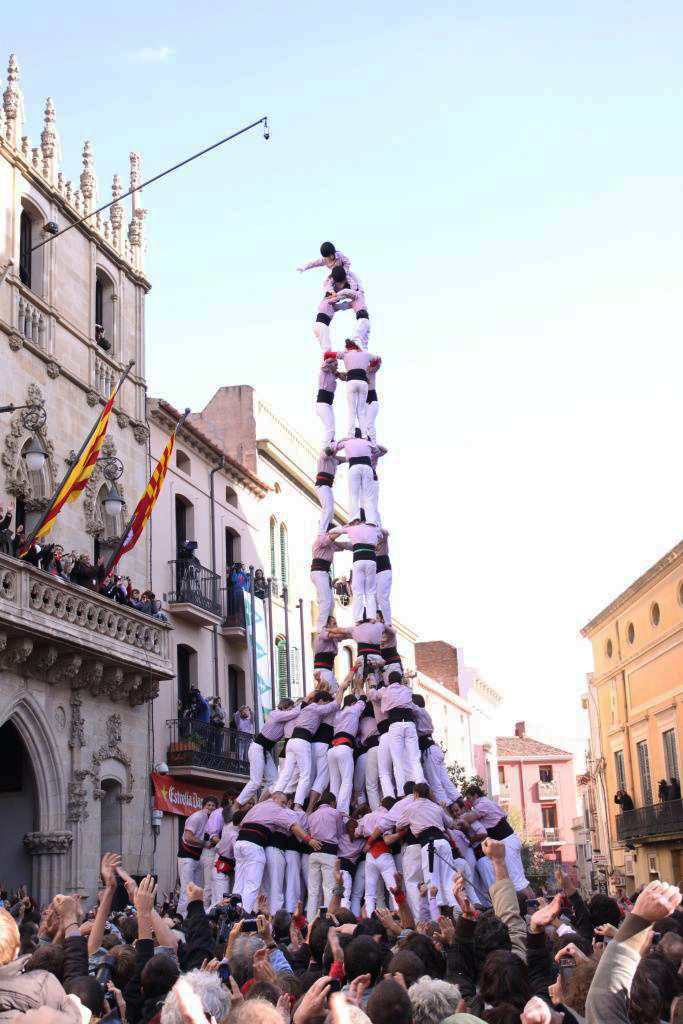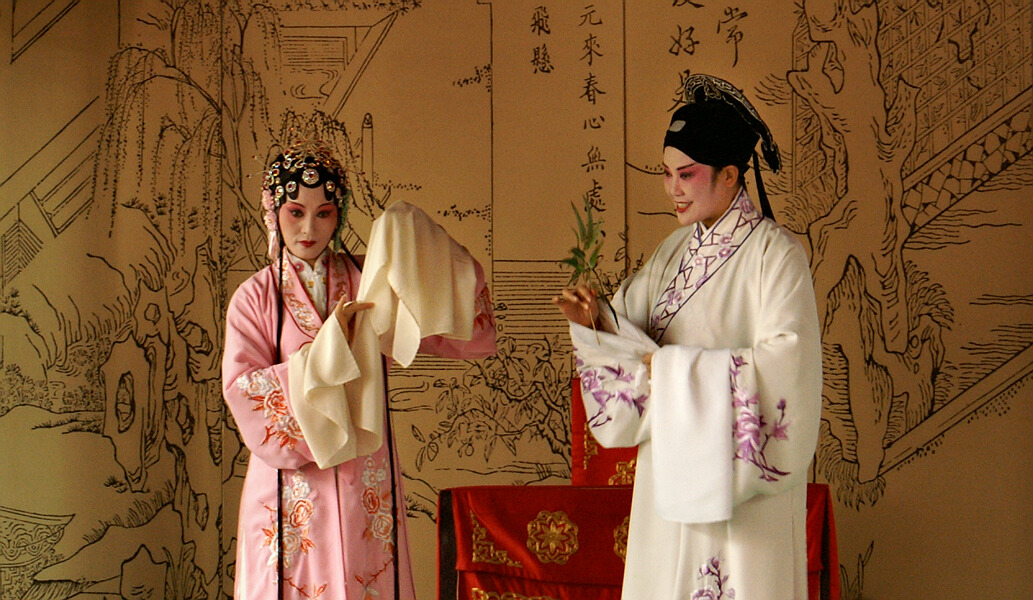|
Castell
A ''castell'' () is a human tower built traditionally at festivals in Catalonia, the Balearic islands and the Valencian Community. At these festivals, several ''colles castelleres'' (teams that build towers) attempt to build and dismantle a tower's structure. On 16 November 2010, ''castells'' were declared by UNESCO to be amongst the Masterpieces of the Oral and Intangible Heritage of Humanity. Origin Although based on the earlier traditional Muixeranga of Algemesí in Valencia, the tradition of ''castells'' within Catalonia originated in the ''Ball dels Valencians'' (Valencian Dance) in Valls, near the city of Tarragona, first documented in 1712. Over the course of the 18th century, they spread to other towns and cities in the area, including Vilafranca del Penedès and Tarragona, though it was not until the last 50 years that the practice of building ''castells'' began to spread to the rest of Catalonia. Interest in castells began to grow in the 1960s and 1970s. In the 1980s ... [...More Info...] [...Related Items...] OR: [Wikipedia] [Google] [Baidu] |
Castellers De Vilafranca
The Castellers de Vilafranca () is a cultural and sporting association whose main objective is to build castells (human towers). It has the status of a public-interest association. The group was founded in 1948 in response to the increased interest in human tower building in Vilafranca del Penedès, a Catalan tradition that has evolved since the 18th century Ball de Valencians, a dance from Valencia. In 2010, the Castellers de Vilafranca had about 400 active human tower building members. History The Castellers de Vilafranca cultural association was founded in September 1948 by Oriol Rossell, who became the first ''cap de colla'' (Leader/Technical Manager of the group). The group started with seven-level towers, and forged close relationships with casteller groups in other towns. The first ''caps de colla'' were Oriol Rossell (1948–1952) and Ramon Sala (1953–1955). The group originally wore rose-coloured shirts, and later red ones. In 1956, the group became almost inac ... [...More Info...] [...Related Items...] OR: [Wikipedia] [Google] [Baidu] |
Valls
Valls () is a city and municipality in the province of Tarragona in Catalonia, Spain. According to the 2014 census it has a population of 24,570. Valls is known for its calçots – a type of scallion or green onion – and the human towers tradition known as the castells. The town is the birthplace of the composer Robert Gerhard (1896–1970). Geography Valls is the capital of the ''comarca'' of Alt Camp. With a population of 24,570 inhabitants in 2014, it represents more than half of the population of the county. It is located in the area known as Camp de Tarragona next to the River Francolí, near Reus (Baix Camp) and Tarragona (Tarragonès), the capital of the province. Culture Valls is known for its culinary tradition, the feasting on calçots at what is known as a "calçotada". The calçots are a large type of sweet-flavoured spring onion, barbecued over a pit of flaming vines, and eaten piping hot with a sauce. The calçotada continues with a main course of meats and ... [...More Info...] [...Related Items...] OR: [Wikipedia] [Google] [Baidu] |
Castellers De Barcelona
Castellers de Barcelona () is a team of castellers from Barcelona founded in 1969. It is the first team to be founded outside the traditional area of human towers and the 5th team ever founded. Their first public display was 8 June 1969 in Vendrell. Their shirt is red, and their most important appointment is the closest Sunday to ''Dia de la Mercè'' (24 September), in Plaça Sant Jaume. In 2000, the group received the Medal of Honor of Barcelona and two years later (December 3, 2002), for its castellera and civic trajectory, the Castellers of Barcelona were distinguished with the Cross of St. George Award by the Generalitat of Catalonia. They have crowned almost all the human towers on the range of eight stories and the basic ones of nine. The best human towers crowned by the team are: 5 of 8, 4 of 8 with the needle, 3 of 9 with extra base, 4 of 9 with extra base, 7 of 8 and the pillar of 7 with extra base. They have received the following awards: the Creu de Sant Jordi of Gener ... [...More Info...] [...Related Items...] OR: [Wikipedia] [Google] [Baidu] |
Catalonia
Catalonia (; ca, Catalunya ; Aranese Occitan: ''Catalonha'' ; es, Cataluña ) is an autonomous community of Spain, designated as a ''nationality'' by its Statute of Autonomy. Most of the territory (except the Val d'Aran) lies on the northeast of the Iberian Peninsula, to the south of the Pyrenees mountain range. Catalonia is administratively divided into four provinces: Barcelona, Girona, Lleida, and Tarragona. The capital and largest city, Barcelona is the second-most populated municipality in Spain and the fifth-most populous urban area in the European Union.Demographia: World Urban Areas – Demographia, April 2018 Current day Catalonia comprises most of the medieval and early modern Principality o ... [...More Info...] [...Related Items...] OR: [Wikipedia] [Google] [Baidu] |
Castle
A castle is a type of fortified structure built during the Middle Ages predominantly by the nobility or royalty and by military orders. Scholars debate the scope of the word ''castle'', but usually consider it to be the private fortified residence of a lord or noble. This is distinct from a palace, which is not fortified; from a fortress, which was not always a residence for royalty or nobility; from a ''pleasance'' which was a walled-in residence for nobility, but not adequately fortified; and from a fortified settlement, which was a public defence – though there are many similarities among these types of construction. Use of the term has varied over time and has also been applied to structures such as hill forts and 19th-20th century homes built to resemble castles. Over the approximately 900 years when genuine castles were built, they took on a great many forms with many different features, although some, such as curtain walls, arrowslits, and portcullises, were ... [...More Info...] [...Related Items...] OR: [Wikipedia] [Google] [Baidu] |
Muixeranga
The ''Muixeranga'' () is the collective name given to the performance of ancient street dances and human pyramids or ''castells'', originating in the ancient Kingdom of Valencia (currently the Land of Valencia), which are still preserved in the town of Algemesí, southwest from Valencia, and certain other Valencian towns. The ''muixeranga'' is much more than an artistic acrobatic dance. It is a collection of ancient human choreographies of enormous plasticity illustrating various figures and shapes, which are held during the Algemesí town festival (September 7 and 8th), in honor of the Virgin of Health (''Mare de Déu de la Salut''). The ''Muixeranga'' resembles the modern ''castellers'' in many ways, the latter being spread all over Catalonia. Both traditions share the same origin, the "Moixiganga", (a series of dances of human towers) once found throughout the Iberian Peninsula. Muixeranga differs from castellers mainly in that the ''Muixeranga'' has a religious background a ... [...More Info...] [...Related Items...] OR: [Wikipedia] [Google] [Baidu] |
Minyons De Terrassa
Minyons de Terrassa is a group of castellers from Terrassa Terrassa (, es, Tarrasa) is a city in the east central region of Catalonia, Spain, in the province of Barcelona, ''comarca'' of Vallès Occidental, of which it is the co-capital along with Sabadell. The name ''Terrassa'' derives from Latin ' ... and publicly presented on 14 July 1979. On 22 November 2015, they became the first group ever to successfully complete and dismantle a ''4 de 10 amb folre i manilles''. References External links Terrassa Castellers Catalan folklore {{Catalonia-stub ... [...More Info...] [...Related Items...] OR: [Wikipedia] [Google] [Baidu] |
Catalan Language
Catalan (; autonym: , ), known in the Valencian Community and Carche as ''Valencian'' (autonym: ), is a Western Romance language. It is the official language of Andorra, and an official language of three autonomous communities in eastern Spain: Catalonia, the Valencian Community, and the Balearic Islands. It also has semi-official status in the Italian comune of Alghero. It is also spoken in the Pyrénées-Orientales department of France and in two further areas in eastern Spain: the eastern strip of Aragon and the Carche area in the Region of Murcia. The Catalan-speaking territories are often called the or "Catalan Countries". The language evolved from Vulgar Latin in the Middle Ages around the eastern Pyrenees. Nineteenth-century Spain saw a Catalan literary revival, culminating in the early 1900s. Etymology and pronunciation The word ''Catalan'' is derived from the territorial name of Catalonia, itself of disputed etymology. The main theory suggests that (Latin ... [...More Info...] [...Related Items...] OR: [Wikipedia] [Google] [Baidu] |
Masterpieces Of The Oral And Intangible Heritage Of Humanity
The Proclamation of Masterpieces of the Oral and Intangible Heritage of Humanity was made by the Director-General of UNESCO starting in 2001 to raise awareness of intangible cultural heritage and encourage local communities to protect them and the local people who sustain these forms of cultural expressions. Several manifestations of intangible heritage around the world were awarded the title of ''Masterpieces'' to recognize the value of the non-material component of culture, as well as entail the commitment of states to promote and safeguard the Masterpieces. Further proclamations occurred biennially. In 2008, the 90 previously proclaimed Masterpieces were incorporated into the new Representative List of the Intangible Cultural Heritage of Humanity as its first entries. Background UNESCO defines oral and intangible heritage as "the totality of tradition-based creations of a cultural community expressed by a group or individuals and recognized as reflecting the expectations of a ... [...More Info...] [...Related Items...] OR: [Wikipedia] [Google] [Baidu] |
Valencian Country
The Valencian Community ( ca-valencia, Comunitat Valenciana, es, Comunidad Valenciana) is an autonomous community of Spain. It is the fourth most populous Spanish autonomous community after Andalusia, Catalonia and the Community of Madrid with more than five million inhabitants.Instituto Nacional de Estadística, Madrid, 2020. Its homonymous capital Valencia is the third largest city and metropolitan area in Spain. It is located along the Mediterranean coast on the east side of the Iberian Peninsula. It borders with Catalonia to the north, Aragon and Castilla–La Mancha to the west, and Murcia to the south, and the Balearic Islands are to its east. The Valencian Community consists of three provinces which are Castellón, Valencia and Alicante. According to Valencia's Statute of Autonomy, the Valencian people are a ''nationality''. Their origins date back to the 1238 Aragonese conquest of the Taifa of Valencia. The newly-founded Kingdom of Valencia enjoyed its own legal entity ... [...More Info...] [...Related Items...] OR: [Wikipedia] [Google] [Baidu] |
Valencian Community
The Valencian Community ( ca-valencia, Comunitat Valenciana, es, Comunidad Valenciana) is an autonomous community of Spain. It is the fourth most populous Spanish autonomous community after Andalusia, Catalonia and the Community of Madrid with more than five million inhabitants.Instituto Nacional de Estadística, Madrid, 2020. Its homonymous capital Valencia is the third largest city and metropolitan area in Spain. It is located along the Mediterranean coast on the east side of the Iberian Peninsula. It borders with Catalonia to the north, Aragon and Castilla–La Mancha to the west, and Murcia to the south, and the Balearic Islands are to its east. The Valencian Community consists of three provinces which are Castellón, Valencia and Alicante. According to Valencia's Statute of Autonomy, the Valencian people are a ''nationality''. Their origins date back to the 1238 Aragonese conquest of the Taifa of Valencia. The newly-founded Kingdom of Valencia enjoyed its own legal entit ... [...More Info...] [...Related Items...] OR: [Wikipedia] [Google] [Baidu] |

.jpg)






